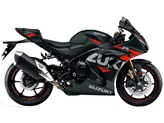Yamaha R1 2015 vs. Suzuki GSX-R 1000 2017

Yamaha R1 2015

Suzuki GSX-R 1000 2017
Visão geral - Yamaha R1 2015 vs Suzuki GSX-R 1000 2017
The Yamaha R1 model year 2015 and the Suzuki GSX-R 1000 model year 2017 are both supersport motorcycles that offer high-performance capabilities.
In terms of the engine and drivetrain, the Yamaha R1 2015 has a bore of 79 mm and a stroke of 50.9 mm, while the Suzuki GSX-R 1000 2017 has a bore of 76 mm and a stroke of 55.1 mm. The Yamaha R1 2015 has a power output of 200 HP and a torque of 112.4 Nm, while the Suzuki GSX-R 1000 2017 has a power output of 202 HP and a torque of 118 Nm. Both motorcycles have a compression ratio of around 13, indicating their high-performance capabilities. They both have 4 cylinders and 4 valves per cylinder, with DOHC valve configuration. The displacement of the Yamaha R1 2015 is 998 cc, while the Suzuki GSX-R 1000 2017 has a displacement of 999 cc.
In terms of suspension, both motorcycles feature a telescopic front fork. The chassis of the Yamaha R1 2015 is made of aluminum and has a Deltabox frame, while the Suzuki GSX-R 1000 2017 has an aluminum frame with a twin-spar design.

Yamaha R1 2015
Both motorcycles have dual disc front brakes for efficient stopping power. The Yamaha R1 2015 comes with advanced rider assistance systems such as launch control and traction control, while the Suzuki GSX-R 1000 2017 offers additional features such as ABS, riding modes, ride-by-wire, and traction control.
In terms of dimensions and weights, both motorcycles have a front tire width of 120 mm and a rear tire width of 190 mm, with a 17-inch diameter for both front and rear tires. The Yamaha R1 2015 has a wheelbase of 1405 mm and a seat height of 855 mm, while the Suzuki GSX-R 1000 2017 has a slightly longer wheelbase of 1410 mm and a lower seat height of 825 mm. The Yamaha R1 2015 has a curb weight of 199 kg with ABS, while the Suzuki GSX-R 1000 2017 weighs slightly more at 202 kg with ABS. Both motorcycles have a fuel tank capacity of 17 liters, allowing for longer rides without frequent refueling.

Suzuki GSX-R 1000 2017
In terms of strengths, the Yamaha R1 2015 is praised for its incredible sound, strong peak rotation, thrilling racing experience, superior electronic package, and high-quality finish. On the other hand, the Suzuki GSX-R 1000 2017 is praised for its high-revving engine, seamless torque curve, superb stability on corner exits and in the turn radius, excellent gearbox, high-quality chassis, and exceptional performance on fast tracks.
As for weaknesses, the Yamaha R1 2015 is criticized for its lack of torque in the mid-range and stability during braking. The Suzuki GSX-R 1000 2017, on the other hand, is noted for its non-adjustable engine brake.
Overall, both the Yamaha R1 2015 and the Suzuki GSX-R 1000 2017 are highly capable supersport motorcycles with their own unique strengths and weaknesses. The choice between the two would ultimately depend on the rider's preferences and priorities in terms of performance, handling, and features.
Especificações técnicas Yamaha R1 2015 em comparação com Suzuki GSX-R 1000 2017
Prós e contras em comparação
Prós e contras em comparação
Yamaha R1 2015

A nova R1 é um grande sucesso e já não se compara ao modelo anterior. Esta era considerada uma boa mota de estrada rural e era necessário fazer grandes investimentos para as excursões às pistas de corrida. Agora é o contrário. A nova R1 foi desenvolvida com um claro enfoque na pista de corrida. O pacote eletrónico parece extraordinário, os fanáticos por tecnologia terão o que merecem. Os fãs da Yamaha têm de a comprar, finalmente têm uma mota digna. A R1 tem ligeiras fraquezas na travagem - torna-se um pouco instável. Se quiser comprar uma moto de competição pronta a usar, sem ter de trabalhar no chassis, é melhor optar pela R1M. A suspensão eletrónica Öhlins funciona perfeitamente e não tem pontos fracos. Para uma utilização pura em pista, o segundo ponto fraco da R1 pode ser facilmente resolvido. O buraco de binário no meio pode ser facilmente eliminado com um novo mapeamento.
Suzuki GSX-R 1000 2017

A Suzuki fez um excelente trabalho com a GSX-R 1000 2017. Uma moto super-forte com uma curva de binário fabulosamente suave. Realmente inacreditável com 202 cv! O chassis é de alta qualidade e o pacote eletrónico não tem nada de especial, mas proporciona um desempenho de topo.
Comparação de preços Preço médio de mercado Yamaha R1 vs Suzuki GSX-R 1000
There are a few key differences between a Yamaha R1 2015 and a Suzuki GSX-R 1000 2017. It takes less time to sell a Yamaha R1 with 76 days compared to 121 days for a Suzuki GSX-R 1000. Since model year 2005 1000PS.de editors have written 80 reviews for the Yamaha R1 and 71 reviews for the Suzuki GSX-R 1000 since model year 2005. The first review for the Yamaha R1 was published on 28/04/2003 and now has more than 3.900 views. This compares to more than 7.100 views for the first review on Suzuki GSX-R 1000 published on 03/03/2004.























